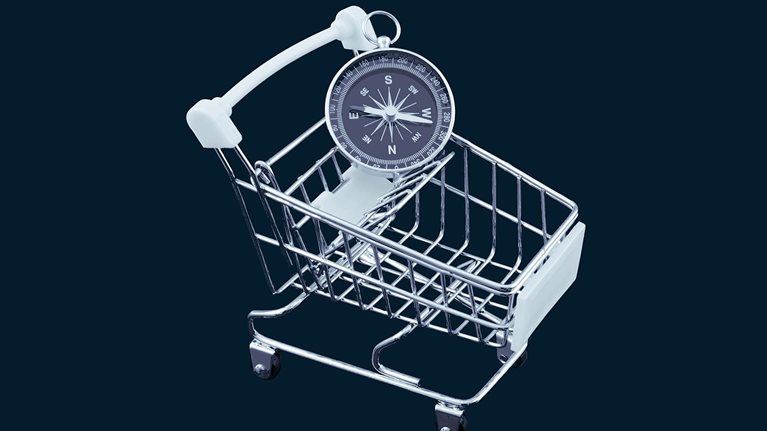With the rapid emergence of a wide array of technologies in recent years—many with the potential to change the retail industry—one consistent trend has become apparent: retailers that are capable of adopting and deploying new technologies across many parts of their business—commerce, supply chain, store, and customer-facing—are typically more successful.
Accordingly, grocery retailers have been on the hunt for technologies that can help them leapfrog their competitors. But finding and implementing new solutions can also result in high costs and disappointing delays due to inflexible legacy tech platforms.
Yesterday’s digital strategies, such as multiyear targets and corresponding road maps, no longer suffice given the fast rate of change in grocery retail. Pure online players and innovative incumbents are constantly on the move; by the time they complete their two-year road map, the world looks different again. Now, fully automated replenishment software and microfulfillment centers are streamlining supply and operations, with advanced analytics increasingly optimizing a grocer’s supply chain end to end. And who could have predicted the explosive growth of online grocery shopping due to COVID-19 restrictions?
With e-commerce being a substantial part of their business now, retailers are trying to build a truly omnichannel proposition and corresponding tech platform—which is no easy feat. At the same time, on the commercial side, merchandisers are increasingly working with largely automated, advanced tools to optimize pricing, promotion, assortment, and sourcing.
Agile, digitally savvy retailers that can derive the most benefit from new technologies will speed ahead of competitors and increase the value they provide to shareholders. Our analysis shows that total return to shareholders (TRS) for consumer and retail companies that are technology leaders grew at a CAGR of 14 percent from 2017 to 2020, while laggards’ TRS decreased by 5 percent CAGR (Exhibit 1).

To become a tech leader that can adapt to changing circumstances, grocers can look to these five key principles for guidance:
1. Build a product-led organization
A nimble and successful tech organization is able to shift resources among priorities on short notice. It’s crucial for executives to build organizations around products and not solely focus on applications. Leading grocery retailers do this by defining business domains and mapping out product teams for each domain. Retailers could have multiple products per business domain. Each domain should be defined at such a granular level that a small team of engineers can own the development end to end (Exhibit 2). This cross-functional team comprises business and tech talent and is responsible for advancing the product’s performance and overarching vision. As market dynamics change, products and their teams can be expanded, reduced, or morphed into new products and teams to capitalize on new opportunities. These business-domain product maps help organizations highlight strategic priorities, set measurable business targets, and enable trade-offs when reprioritization is necessary.

While most leading players are building such product teams using in-house tech talent, the same applies for those opting for an outsourced or partner model. Smaller players, for example, may not be able to build a full-fledged in-house team in all technology domains. Still, the logic of a product organization would apply: technology partners should replicate a retailer’s internal product logic on their end. Whatever the chosen model, some degree of internal control on technical quality will always be required for success.
2. Create a real tech workforce
To cope with underlying uncertainties and master new technologies, cutting-edge grocers are making sure they have the right talent, while also providing ongoing training opportunities for employees to level up where gaps exist. Today, many grocery retailers rely heavily on external developers, who may not always have the right capabilities or be able to deliver in a timely manner. The most successful organizations develop an internal tech workforce complemented with external talent where it enriches or accelerates productivity. Building capabilities, however, should not stop at the operational level. For example, building an enterprise resource planning competence center could help organizations respond to uncertainties. With technology becoming an important driver of the business model, the decision makers should also have a better understanding of how technology works (see sidebar, “The agile approach in action”).
At the same time, it’s important to recognize that the current workforce includes thousands of digitally savvy frontline personnel who are working in tough conditions in stores and are rapidly adopting new collaboration tools. Technology can make it easier to manage their shifts and tasks while helping them stay safe and healthy.
Would you like to learn more about our Retail Practice?
3. Build architecture modules driven by business strategy
The most successful new technology developments follow a modular approach that is consistent and reusable across channels. This requires cutting legacy landscapes into smaller, self-sufficient services that can be improved independently from other parts of the landscape. At the same time, these services should be able to provide data to whichever other applications need it, without having to implement individualized point-to-point connections. This allows the development speed to accelerate and provides a consistent customer experience across multiple front ends, such as in-store point-of-sale (POS) systems, web shops, and apps.
Take, for instance, omnichannel basket calculation: while this task is often a pain point for grocers, when it is adaptable it can be used in every channel, thus allowing for easier inclusion of new features such as couponing, personalized promotions, and further loyalty features.
In addition, there is another driver for a landscape renewal: stores are increasingly becoming nodes in an omnichannel ecosystem for use cases such as click and collect, local promotions, and last-mile deliveries. The underlying technology architecture needs to be able to operate with sufficient flexibility to integrate third parties such as delivery partners.
4. Shorter time to market
Shorter release cycles allow retailers to better understand and meet customer expectations, while also enabling swift experimentation. Instead of big code releases a few times per year or month, teams should deliver releases multiple times per day in customer-facing systems and multiple times per month in back-end systems that incorporate real user feedback to adjust products quickly. This can be done only if modern technology practices, such as automated code deployment, are in place.
5. Use data as the foundation for all improvements
Data are more abundant and flowing faster and across more boundaries than ever. It is no longer enough to capture structured transactional and supply-chain data. Instead, grocers need to capture millions of daily events and interactions so they can be analyzed to optimize experience and productivity. New technologies in this space are providing more flexibility—to rapidly capture, process, and analyze these data—than ever.
Data can supercharge improvements, helping companies keep close tabs on changing consumer demand. No longer is experience alone enough to make decisions. Wherever possible, direct user feedback can identify areas to improve and inform decisions about further priorities. Investments into suitable tools, such as A/B testing and performance monitoring, allow companies to better access and apply user feedback.
To get started on a tech transformation, companies are using the following strategies:
Make technology transformation a top strategic priority instead of simply an IT upgrade. The mission to transform the organization through technology should be high on the CEO’s agenda rather than coming from within the IT department. The corporate mindset should shift from measuring tech spend as a percent of revenue to measuring tech spend based on the productivity and growth it is enabling outside of IT.
Focus on tech opportunities that provide the highest business value. While an endless number of possible improvements exist, consider creating minimal viable products to make the case for value quickly. Focus on doing a few things really well to generate traction and a (at least partially) self-funding road map.
Shorten technology planning cycles. Moving from an annual planning cycle to a flexible planning model with a monthly or at least quarterly time frame allows rapid prioritization and deprioritization of products based on continuous value delivery.
Embrace the change as an enterprise-wide transformation. Instead of the change being limited to certain functions, a company-wide approach will maximize impact and prevent the change from creating different cultures within the company.
Make your entire leadership team accountable for the technology change in their domains. True agile transformation requires the entire board, the C-suite, and their teams to work across functions and silos.
Now is the time to change and make the best use of technology in grocery—not by exactly planning which technologies will be used when but by ensuring the company is transforming nimbly. The overarching objective is to build the flexibility and muscle to master the different technologies existing today and the new ones of tomorrow.
This article is a part of the Retail practice’s new annual report on the grocery industry, which summarizes major trends insights that are new and relevant for the grocery market, giving the reader a content edge and best practice guides. It is produced in collaboration with EuroCommerce, an organization representing the retail sector in the EU.


